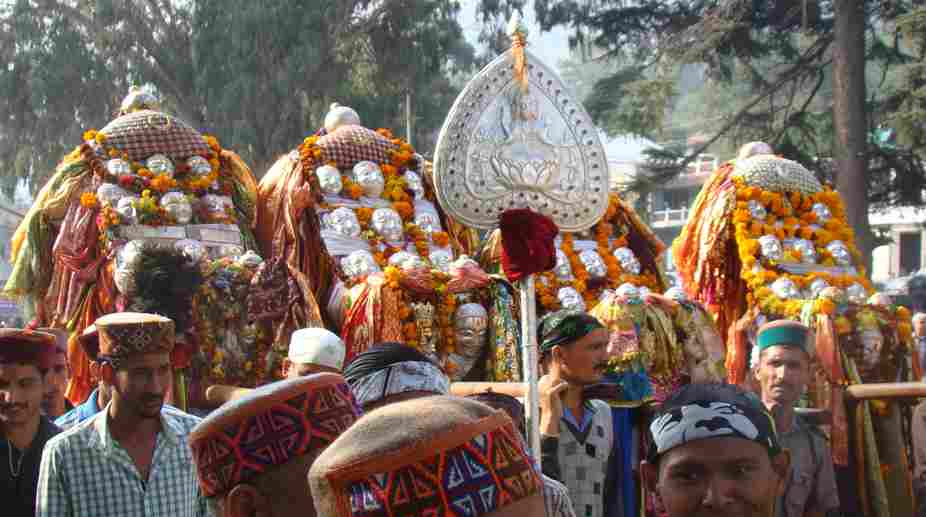BJP manifesto yet another poll gimmick: Pratibha Singh
Himachal Pradesh Congress President and MP Pratibha Singh has termed BJP’s Lok Sabha poll manifesto yet another poll ‘gimmick’.

(Photo: SNS)
Gods living in tents and getting ‘nazrana’ (honorarium) for their participation in an event.
Sounds unbelievable. But Kullu Dussehra in Himachal Pradesh is all about this Godly show, where the divine powers actually turn guests to the mundane authorities.
The international Dusshehra festival in Kullu began on 30 September, the day when it ended in other parts of the country with the burning of effigies of Ravana, Kumbkaran and Meghnath on Vijaydashmi.
Advertisement
The town was witness to deities (‘living’ Gods) descend from entire Kullu district for ‘dev milan’ during the week-long festivity. The environs just turned mesmerising as around 250 deities, decked up with sparkling ornaments and dazzling attires, queued up to bow before Lord Raghunath, principal deity of the area.
“It was spectacular to watch the deities on decorated palanquins and their ‘kardars’ (representatives) and workers covering two-three day journey through the remote areas on foot to reach the town, a day before the festival,” said JN Verma from Lucknow.
The deities have a strong influence on lives of hill folks.
People have extreme faith on the deities for day-to-day activities and do not defy their orders, fearing wrath of the ‘living’ Gods.
“We start the preparations months in advance. It is difficult to handle the sensitive job as all arrangements for the deities have to be foolproof, right from stay to their nazrana,” said a district official. The total nazrana distributed to the deities for participation runs over Rs 60 lakhs. The Dusshehra Committee has been managing funds partly by auctioning tents and advertisements for souvenirs and partly by support of departments of Tourism, Language, Art and Culture.
As the tradition goes, all the deities in Kullu live in earmarked tents for seven days to be a part of the sacred ceremony.
On the opening day, each deity visits the temple of Lord Raghunath in procession, bows before him and then marks presence at the ‘dev sthan’ (place of Gods) in Raja’s palace. By evening, all of them line up around Lord Raghunath’s wooden chariot in sprawling Dhalpur grounds. Finally, the chariot (carrying Lord Raghunath), which has wooden wheels and has ropes attached to it, is pulled by locals through extreme rush of people in the midst of beating of traditional drums and trumpets to mark the beginning of Dussehra festival.
All the deities join ‘shobha yatra’ to take Lord Raghunath’s to the specially erected bigger camp (where the principal deity has to stay for seven days). One deity turns a pilot at the ‘yatra’ to make way for Lord Raghunath’s chariot, while managing the unmanageable crowds
The deities then return to their own tents and do other obligations. The deities start returning to their homes after ‘Lankadahan’ on seventh day. The festival ends with animal sacrifice, which was banned three years ago by HP High court but was later allowed with some ‘riders’ by the Supreme Court few months ago as an interim relief.
According to veteran writer and an expert on culture, Molu Ram Thakur, the Kullu Dusshehra has a mythological explanation to it. Some people relate it to the history and say it started in 17th century.
“It originated from Raja Jagat Singh, who, in order to cleanse himself of the sin of murder of a Brahmin of Tipri village for his not giving the pearls equal to one patha (about half kilogram) which he possessed, started this tradition. On the advice of a Saint, the statue of Lord Raghunath was brought from Ayodhya, which reached Kullu on the same day in the year 1650 AD. This occasion was celebrated continuously for one week,” explained Thakur in a pictorial book on ‘Gods and Goddesses of Kullu’, brought out by Kullu Dussehra Committee in 2014.
As per history, the Raja then invited all local deities in Kullu from various temples to perform a ritual in honour of Lord Raghunath during Dussehra. Since then, the annual assembly of deities from hundreds of village temples has become a tradition.
The administration has been inviting the deities ever since the rule of princely states came to an end and has been giving an honorarium (‘nazrana’) to deities (received by ‘kardars’) as per their status and seniority for participating in the festival.
Unlike other places, effigies of Ravana, Meghnad and Kumbhakaran are not burnt here.
It is because of this history being carried forward, thousands of locals, tourists, enthusiasts and researchers converge in Kullu to witness the week-long Dussehra festival every year.
“It is one of the biggest traditional, religious and cultural festivities of Kullu in which deities all over the district come to participate. We have to maintain the traditions and values at any cost and pass it on to the future generations,” said Chief Minister, Virbhadra Singh.
Advertisement